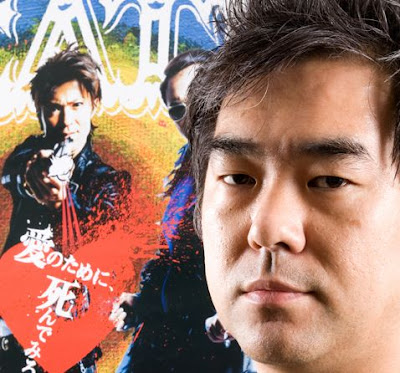 空気人形 (Kuuki Ningyou)
空気人形 (Kuuki Ningyou)
Released: 2009
Director:
Hirokazu Kore-eda
Starring:
Bae Doo Na
Arata
Itsuji ItaoJo Odagiri
Kimiko Yo
Running time: 116 min.
Reviewed by Chris MaGeeHideo (Itsuji Itao) has a thankless existence as a waiter in a chain restaurant. His boss dislikes him, his customers mistreat him. If it weren't for the fact that Hideo has a faithful woman at home his life would be unbearable. This woman is Nozomi - quiet, a great listener, non-judgmental, and beautiful and sexually available to boot. What tired, work-a-day Japanese man could ask for more, plus she was a bargain at ¥5,995. You see Nozomi is an inflatable sex doll, or "Air Doll" and it's from this substitute for sexual desire by lonely men like Hideo that director Hirokazu Kore-eda takes the title of his latest film.
This tale of urban alienation has a twist though. Nozomi doesn't remain a vinyl sex aide. Through magic, circumstance or just constant use this air doll finds herself gaining a heart and suddenly coming to life. The newly sentient and mobile Nozomi (played by Korean actress Bae Doo Na of "The Host" and "Linda, Linda, Linda" fame) keeps this miracle a secret from Hideo, deciding to only get up and explore the human world when Hideo is at work. Dressing in the maid costume bought for her by Hideo she heads out into the streets of Tokyo observing its denizens with a child-like sense of wonder. It's on one of these forays that she stumbles into a video store called Cinema Circus, and it's there that she eventually gets a job and meets Junichi (Arata), a young man who will teach her newly awakened heart how to love.
There has been tremendous buzz building in advance of this, Hirokazu Kore-eda's seventh feature film. This is of course from the man who brought us such contemporary cinematic masterpieces as 1995's "Maborosi", 1998's "After Life" and 2004's "Nobody Knows". I am a huge fan of these three and credit "After Life" for being one of the films that introduced me to Japanese cinema, but I found myself liking instead of loving Kore-eda's last two feature outings, the jidai-geki comedy/drama "Hana" and the Yazujiro Ozu homage "Still Walking", so when I heard that "Air Doll" was his best film since "After Life" I grew even more excited, and cautious.

I was a bit disturbed that as I sat watching the first half of "Air Doll" I again found myself liking, but not loving, the story unfolding on the screen. Nozomi's new life and exploration of her world did indeed bring a smile to my face. The cinematography by Mark Lee Ping Bing, who shot portions of Wong Kar Wai's "In the Mood for Love" and many of Ho Hsiao Hsien's films, was as exquisite as ever, and the playful and moving score provided by World's End Girlfriend perfectly complimented the story. Still there was a feeling of cliche about this modern-day Pinocchio story, that I'd seen scenes from "Air Doll" in other similar films, Ron Howard's "Splash" and Steven Spielberg's "A.I." being two examples. The montage sequences in which Kore-eda shows us the people around Nozomi, the old man on a park bench, a father and his young daughter, a lonely bulimic woman, and an aging beauty (played by "Departures" Kimiko Yo) where wonderful aesthetic experiences and had me wishing that Kore-eda had made "Air Doll" an ensemble film. I feared that, like Nozomi, this film would be beautiful but empty, but it was the performance of Bae Doo Na that ends up giving "Air Doll" the heart that makes it a great film.
The character of Nozomi is a very difficult one. On one hand she can be interpreted as a symbol of female awakening, of a Japanese woman liberated from a servile role at home and bravely going out into the world to forge her own destiny. On the other hand, despite her newfound "heart" she is still a beautiful blank, empty inside and reliant on the men around her to fill her up and giver her meaning. Kore-eda based his film on Yoshiie Goda's manga "The Pneumatic Figure of a Girl" (his very first manga adaptation), the same manga author who brought us "Jigyaku no uta" which formed the basis of Yukihiko Tsutsumi's "Happily Ever After", a comedy about a woman stuck with an abusive spouse. Goda obviosuly wants her female characters to take us to unfamiliar or uncomfortable emotional territory, and Bae Doo Na's performance does the exact same thing. Her Nozomi is both sexually alluring, innocent, and funny while at the same time full of disappointment, confusion, and sadness. It's a real accomplishment on Bae Doo Na's part, and for me becomes the true accomplishment of Kore-eda's film - to give Japanese cinema and cinema in general an example of femininity that while enticing is never easy, that takes the metaphor of a sex doll to hone in on aspects of the female experience (liberation vs. servitude, desire vs. objectification) that film sometimes stops just short of addressing.
Kore-eda need not have driven home the point of how everyone in contemporary society is similar to Nozomi, all trying to find our way and all more than a bit empty. The heart of "Air Doll" is in the film's main character, a woman (inflatable or not) who due to some very unexpected twists in the plot (the less said the better) can stand alongside Kenji Mizoguchi's Oharu from "The Life of Oharu" and Yasujiro ozu's and Sestuko Hara's Noriko as complex and compelling cinematic females. It's this that indeed places "Air Doll" amongst Kore-eda's best works.
 by Chris MaGee
by Chris MaGee




























































